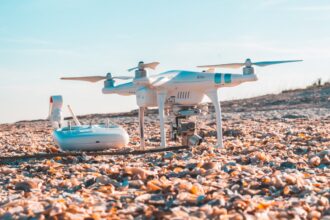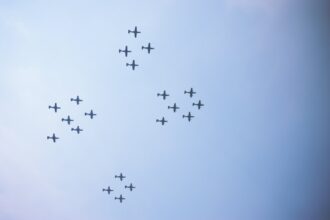Counter-Unmanned Aerial Systems (Counter-UAS) have emerged as a critical component in modern security and defense strategies. As the proliferation of drones continues to rise, so too does the need for effective measures to mitigate potential threats posed by these unmanned aerial vehicles (UAVs). Counter-UAS systems are designed to detect, track, and neutralize unauthorized or hostile drones, ensuring the safety of airspace and protecting sensitive areas from surveillance or attacks.
The increasing accessibility of drone technology has made it imperative for governments, military organizations, and private entities to invest in robust countermeasures. The evolution of Counter-UAS systems reflects the dynamic nature of aerial threats. Initially developed for military applications, these systems have now found relevance in various sectors, including law enforcement, critical infrastructure protection, and event security.
The complexity of countering UAVs lies not only in their diverse capabilities but also in the rapid advancements in drone technology. As such, understanding the limitations of Counter-UAS systems is essential for stakeholders aiming to enhance their operational effectiveness and ensure comprehensive airspace security.
Key Takeaways
- Counter-UAS systems are designed to detect and mitigate unauthorized drones in various environments.
- Technological limitations such as signal interference and limited detection range can impact the effectiveness of counter-UAS systems.
- Operational limitations, including response time and false alarm rates, can affect the overall performance of counter-UAS systems.
- Environmental limitations, such as weather conditions and terrain, can impact the functionality of counter-UAS systems.
- Regulatory limitations, such as restrictions on the use of certain counter-UAS technologies, can pose challenges for deployment and operation.
Technological Limitations
Despite significant advancements in technology, Counter-UAS systems face several inherent limitations that can hinder their effectiveness. One of the primary challenges is the rapid pace of drone innovation. As manufacturers develop more sophisticated UAVs equipped with advanced features such as enhanced stealth capabilities and autonomous flight patterns, existing countermeasures may struggle to keep up.
This technological arms race necessitates continuous research and development to ensure that Counter-UAS systems remain relevant and effective against emerging threats. Moreover, the diversity of drone types presents a significant challenge for detection and neutralization technologies. Drones can vary widely in size, speed, and operational capabilities, making it difficult for a single countermeasure to address all potential threats effectively.
For instance, small consumer drones may evade detection by traditional radar systems designed for larger aircraft. Consequently, Counter-UAS systems must integrate multiple detection methods, including radio frequency (RF) detection, electro-optical sensors, and acoustic sensors, to create a comprehensive solution capable of addressing a wide range of UAVs.
Operational Limitations
Operational limitations also play a crucial role in the effectiveness of Counter-UAS systems. One significant challenge is the need for real-time situational awareness. In dynamic environments where multiple drones may be operating simultaneously, maintaining an accurate understanding of the airspace can be daunting.
Counter-UAS operators must be able to quickly assess threats and respond accordingly, which requires advanced data processing capabilities and seamless communication between various system components. Additionally, the deployment of Counter-UAS systems often requires specialized training for personnel. Operators must be well-versed in the intricacies of drone technology and countermeasures to make informed decisions during critical situations.
This training can be resource-intensive and time-consuming, potentially limiting the availability of skilled personnel when urgent threats arise. Furthermore, the integration of Counter-UAS systems into existing security frameworks can pose logistical challenges, necessitating coordination among various agencies and stakeholders.
Environmental Limitations
| Environmental Limitations | Metrics |
|---|---|
| Temperature | Minimum and maximum temperature range |
| Humidity | Ideal humidity levels |
| Light | Light intensity and duration |
| Soil pH | Optimal pH range for plant growth |
| Water availability | Amount of water required |
Environmental factors can significantly impact the performance of Counter-UAS systems. Weather conditions such as rain, fog, or high winds can hinder the effectiveness of detection and tracking technologies. For instance, adverse weather may obscure visibility for optical sensors or disrupt radio frequency signals used for communication and control.
As a result, operators may find it challenging to accurately identify and neutralize threats during inclement weather. Geographical features also play a role in the operational effectiveness of Counter-UAS systems. Urban environments with tall buildings can create obstacles that interfere with signal transmission and reception, complicating detection efforts.
Similarly, mountainous or densely forested areas may limit the range and effectiveness of certain countermeasures. To address these environmental limitations, Counter-UAS systems must be designed with adaptability in mind, allowing for adjustments based on specific operational contexts.
Regulatory Limitations
The regulatory landscape surrounding drone operations presents another layer of complexity for Counter-UAS systems. Governments worldwide are grappling with how to balance the benefits of drone technology with the need for public safety and security. As a result, regulations governing the use of Counter-UAS systems can vary significantly from one jurisdiction to another.
In some regions, strict laws may limit the deployment of certain countermeasures, particularly those involving kinetic responses such as jamming or physical interception.
Operators must navigate a complex web of laws regarding airspace management, privacy rights, and liability issues when engaging with unauthorized UAVs.
This regulatory uncertainty can create hesitancy among organizations considering the implementation of Counter-UAS systems, as they may fear legal repercussions or public backlash if their actions are perceived as excessive or unwarranted.
Cost Limitations
Cost considerations are a significant factor influencing the adoption and deployment of Counter-UAS systems. Developing and maintaining advanced countermeasures can require substantial financial investment, which may be prohibitive for smaller organizations or municipalities with limited budgets. The initial costs associated with purchasing sophisticated detection and neutralization technologies can deter potential users from investing in these systems.
Furthermore, ongoing operational costs must also be taken into account. Regular maintenance, personnel training, and system upgrades are essential to ensure that Counter-UAS systems remain effective over time. For many organizations, particularly those in the public sector, securing funding for these ongoing expenses can be challenging.
As a result, cost limitations can restrict access to advanced countermeasures and hinder efforts to enhance airspace security.
Size and Weight Limitations
The size and weight of Counter-UAS systems can also pose significant challenges in their deployment and effectiveness. Many advanced detection technologies require substantial physical infrastructure that may not be feasible in all operational environments. For instance, large radar systems may be impractical for temporary installations at events or in urban settings where space is limited.
Additionally, the weight of certain countermeasures can restrict their mobility and versatility. Portable systems designed for rapid deployment must strike a balance between effectiveness and ease of transport. If a system is too cumbersome or heavy, it may not be deployable in time to address an imminent threat.
Therefore, manufacturers must prioritize designing lightweight yet effective solutions that can be easily transported and set up in various environments.
Detection Range Limitations
Detection range is a critical factor influencing the effectiveness of Counter-UAS systems. Many detection technologies have inherent limitations regarding how far they can accurately identify and track UAVs. For example, radar systems may struggle to detect small drones at significant distances due to their size and low radar cross-section.
This limitation can result in delayed responses to potential threats, increasing the risk of incidents occurring before operators have an opportunity to intervene. Moreover, environmental factors such as terrain and weather conditions can further reduce detection ranges. In urban areas with numerous obstructions or in rural settings with challenging topography, detection capabilities may be compromised.
To address these challenges, developers must focus on enhancing detection technologies to extend their range while maintaining accuracy and reliability.
Response Time Limitations
The response time associated with Counter-UAS systems is another critical consideration that can impact their overall effectiveness. In high-stakes situations where unauthorized drones pose immediate threats—such as during public events or near sensitive infrastructure—rapid response capabilities are essential. However, delays in detection or decision-making processes can hinder timely interventions.
Several factors contribute to response time limitations. The complexity of data processing required to assess threats accurately can introduce delays in decision-making. Additionally, if operators are not adequately trained or if communication between system components is inefficient, response times may suffer further.
To enhance operational effectiveness, organizations must prioritize streamlining processes and ensuring that personnel are well-prepared to act swiftly when faced with potential threats.
False Alarm Limitations
False alarms represent a significant challenge for Counter-UAS systems, as they can undermine confidence in the technology and lead to unnecessary disruptions. The occurrence of false positives—instances where benign objects are mistakenly identified as threats—can result in wasted resources and operational inefficiencies. Moreover, frequent false alarms may desensitize operators over time, potentially leading them to overlook genuine threats.
The causes of false alarms can vary widely depending on the detection technologies employed. For instance, environmental factors such as birds or other airborne objects may trigger alerts in radar systems designed to detect UAVs. To mitigate this issue, developers must focus on refining detection algorithms and improving sensor fusion techniques to enhance accuracy while minimizing false positives.
Interoperability Limitations
Interoperability limitations present another challenge for organizations seeking to implement effective Counter-UAS solutions. Many existing systems operate independently without seamless integration with other security technologies or platforms. This lack of interoperability can hinder information sharing between different agencies or departments responsible for airspace security.
Furthermore, as new technologies emerge and existing systems evolve, ensuring compatibility across various platforms becomes increasingly complex. Organizations must invest time and resources into developing standardized protocols that facilitate communication between different Counter-UAS solutions while also considering future advancements in drone technology. By prioritizing interoperability, stakeholders can enhance their overall situational awareness and response capabilities when addressing potential aerial threats.
In conclusion, while Counter-UAS systems play a vital role in safeguarding airspace from unauthorized drones, they are not without limitations. Technological challenges, operational constraints, environmental factors, regulatory hurdles, cost considerations, size restrictions, detection range issues, response time delays, false alarm occurrences, and interoperability concerns all contribute to the complexity of effectively countering UAV threats. Addressing these limitations requires ongoing collaboration among stakeholders across various sectors to develop innovative solutions that enhance airspace security while adapting to the ever-evolving landscape of drone technology.
Counter-Unmanned Aerial Systems (Counter-UAS) are increasingly vital in addressing the threats posed by unauthorized drones. However, these systems face several limitations, including detection challenges, false positives, and the rapid evolution of drone technology that can outpace current countermeasures. An insightful article discussing these limitations can be found on




